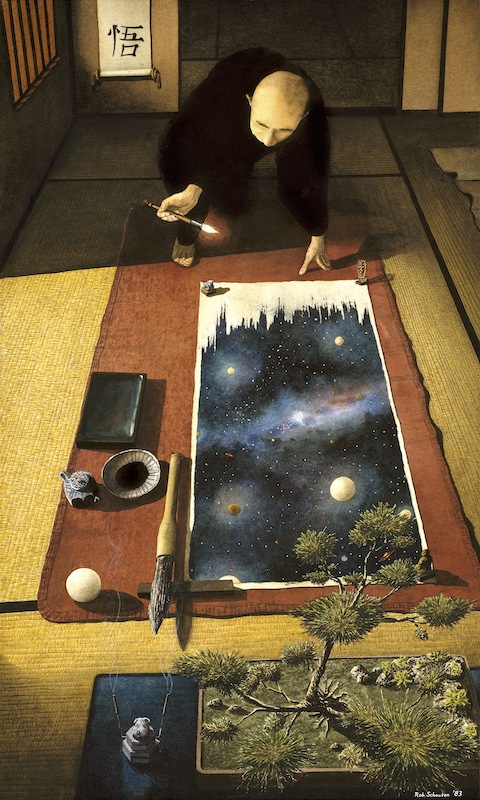We humans are watching a lot these days. We are watching the world from our nose-smudged windows. We are watching the people and pets with whom we are living as we “shelter-in-place.” We are watching our phones for Facebook “likes.” We are watching plenty of television.
I am an Episcopalian – from seven hundred years of Anglicans – though I admit I am not a very good one. Episcopalians and Anglicans are good watchers. It comes naturally to us. We go to church and watch the choir sing Evensong, watch the clergy preside, watch the vestry lead, watch the bishop process, watch the fashions change on the Sunday-best-communion-runway.
Even our denomination’s name emerges from watching. “Episcopalian” comes from the Greek word “episcope” – to watch closely; its etymological roots exposed by sister words like periscope, telescope, and microscope. We are Watchers and we are Holy Ones – both. But not we Episcopalians and not we Christians – rather we sentient beings on the earth.
In his beautiful painting “Satori,” Whidbey Island painter Rob Schouten has a monk “at one with the universe and focused on the act of creating.” It is in this state of “Satori” in which we may find inner peace and from that inner peace, creativity bubbles up. And that creativity has been the agent of art, wonderful meals, great sex, beautiful partnerships, warm friendships, beautiful homes and creative solutions to planetary problems for centuries. We are all creators. All of us.
And yet, I know from the pottery and bee-keeping I have done in my life that if I am unbalanced, rushed, frantic, short-tempered, addicted or agitated, then my engagement with the beehive and the pottery wheel will result in disaster. The clay and the bees respond to agitation. The clay feels it. The bees smell it.
In “Sartori” the monk of this painting reminds us that we are all monks and nuns – we all have an inner life we are shepherding and a creative expression waiting ready inside us like a Border Collie waiting to move sheep – trembling, ready. And of course, in Buddhism, nuns and monks both shave their heads – so we do not know the sex of this monk. Like so many icons, he or she is “we” – all of us.
Notice that at the top of his or her painting of the cosmos, one moon sits placed in the cosmos while another sits off to the side with the larger paintbrush, ready and waiting to be placed. And notice also that the monk has discarded the brush of darkness used to apply the blues and blacks in exchange for the brush dipped in light. And all the while the work and worker are overseen by a tree and garden.
There was a time, many years ago when I bought the idea that an old man in the sky on a throne made heaven and earth and placed us here to worship Him. But as I age, I find that it feels more likely to me that what we have been taught is “God” may not be the whole story – may even be lies meant to manipulate us into better ecclesial subjects to our kings and queens in purple or ermine.
I am not an atheist – I believe in a higher power. Nor am I an agnostic, as I want a relationship with the Holy. But I am becoming aware that the Holy is not in a candle by an altar or in a tabernacle or in a chalice or in a pulpit or in the blessing-hands of the clergy. Holy is light to which we each have access, not dipped from a bowl, but emerging from our hands. In this painting, I see the black ink – the source of the painting’s background in the beautiful ceramic bowl. But I see no second “bowl” of light into which the monk dipped the brush he currently uses to paint light. Could it be that the light comes from within his own peacefulness – his own goodness?
I believe that what good comes from this Corona Pandemic will be from the awareness of the holiness within our own selves – holiness we are able to access by simply picking up a brush, or a saucepan, a pen, or one’s child, knitting needles or sewing needles or gentle conversations – anything that results in new beauty or creativity.
We used to say “Don’t just sit there; do something.” And then pious retreat leaders told us “Don’t just do something; sit there.” But we are now in a new place. The answer to “I wish I could go to church.” and the answer to “I am bored.” are the same: make something. Bless something. Create beauty. Paint paintings. Write poetry. Cook meals. Bake bread. Bless bread. Bless wine. Take. Eat. Nobody need do it for you. Like the monk in Rob’s painting – the brush you now hold is fueled with ink that is uncreated – that flows from your very soul as you, with your one beautiful brief life, paint a new creation.
Image: “Satori” a painting let for this use by the artist – oil on canvas painted by Rob Schouten. © Rob Schouten www.robschoutengallery.com
Charles LaFond is an Episcopal priest, author, speaker, potter, and fundraiser living on the cliffs of an island in the Salish Sea. He writes The Daily Sip (thedailysip.org); which is neither.

